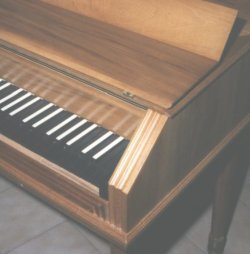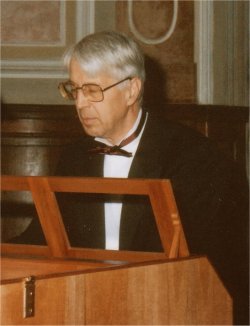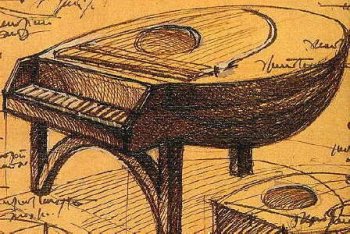
Details on Walter Riemer and his instrument as well as his CD recordings can be found here. |
Fortepiano activities ofWalter RiemerOut of the project of recording the "Art of the Fugue" on a fortepiano In short, these were the results: |
 In our Webshop you can now download any tracks for a small fee in MP3 format (with the exception of "The Art of the Fugue"). |
The fortepiano specialists ...
are limited almost exclusively to music of the actual fortepiano period, from pre-classical over the classical period as far as the romantic period. Depending upon the age and build of the instrument (and/or the model, after which it was copied), for instruments from approximately 1770 to 1790 J.C. Bach, C.P.E. Bach, W.F. Bach, Clementi, Haydn, Mozart and early Beethoven; for instruments from 1790 to approximately 1810 above all Beethoven and early Schubert, for instruments thereafter Schubert, Schumann etc.; in all cases naturally also several contemporaries, so-called “small masters”. There are therefore hundreds of relevant CDs, but only very rarely also recordings with fortepianos that do not fit into this pattern.
How can this be argued against?
Again and again in discussions the modern piano's suitability for performing J.S. Bach is questioned; nevertheless it has become widely accepted practice (except for a few purists). The idea to play J.S. Bach on a fortepiano (preferably of rather early build) surprisingly hardly ever arises (even in the literature!). Often the fact that Bach himself was not at all enthusiastic about the first fortepianos made by Silbermann (although he appreciated later models) is mentioned. In general, there was much criticism of the inflexible sound of the harpsichord even in Bach's time and many yearned for relevant improvement (the much used clavichord was superior in this respect although not suitable as a concert instrument).
My conviction is that Bach would have preferred a fortepiano such as Mozart's to his harpsichord for many of his piano works.
He was sufficiently open-minded to write original works for “Lautenwerck” (a kind of oversized lute resonance body combined with harpsichord action, however gut strings) although this instrument had some serious disadvantages. In general, no one thinks of Domenico Scarlatti: A majority of his Sonatas is written for piano (not harpsichord!). This is easy to explain: Scarlatti spent decades at the Spanish court, where he gave piano instructions and composed many of his Sonatas. There is evidence that there were several early fortepianos at his disposal, including at least one made by Cristofori (with 49 keys, usable for some 90 sonatas), but also some by his foremost pupil Ferrini (56 keys), on which some 450 of the 550 sonatas were playable. |
|
The “Art of the Fugue” made me ponder about this subject. I gave and will also in the future give some solo recitals on my fortepiano. After finishing the “Art of the Fugue” project, some pianists addressed me on my plans on what to do next, and unanimously proposed doing the "Goldberg Variations". The situation is, however, somewhat different: Whereas for the “Art of the Fugue” no dedicated instrumental cast was defined by Bach (I am convinced anyhow: a keyboard instrument), the “Goldberg Variations” are clearly dedicated to the two manual harpsichord. Accordingly one has some difficulties on a piano with only one manual, at least in some of the variations.
The CD “Goldberg Variations” was recorded in 2007 and is available at our web shop .
The “Art of the Fugue” had widely been considered unplayable on a piano for a single player, particularly from the 20th century on; the “Goldberg Variations” were "only" considered extremely difficult. In the meantime some pianists (for instance Sokolov, Koroliov, Kocsics and more recently Hans Petermandl) recorded the “Art of the Fugue” on a (modern) piano and can be proud of having mastered the "unplayable". The situation with the “Goldberg Variations” is somewhat similar; in particular the two exemplary recordings by Glenn Gould should be mentioned.
If these two works (in addition, however of course, the "Well-tempered Piano", Italian Concerto, Chromatic Fantasy and Fugue, Suites and Partitas) are accepted on the modern piano, why should one not also approve the interpretation on a fortepiano, whose sound quality is near to the baroque era, whose bell-like sound, a maximum of transparency, but in particular also its dynamic possibilities are invaluable?
I am trying to help spread these ideas. In this context it seems also worth mentioning that my instrument has been tuned according to Bradley Lehman's rediscovered “Bach temperament” since 2005. Some of my repertoire can be found here.


